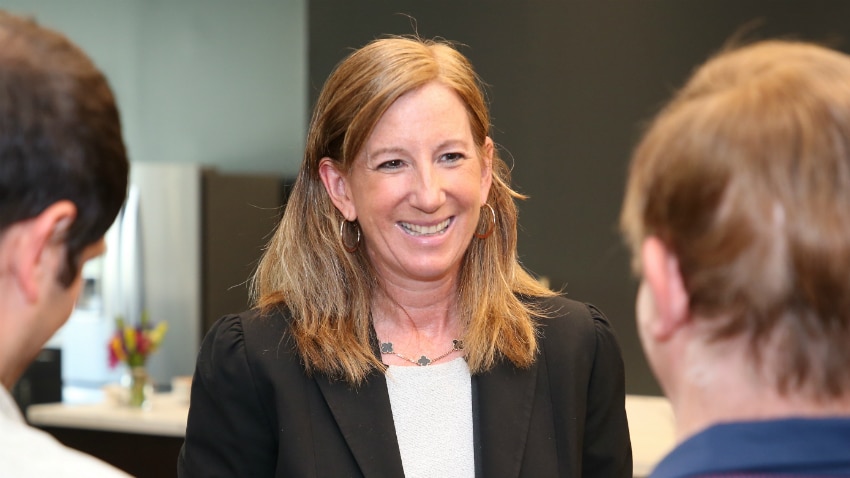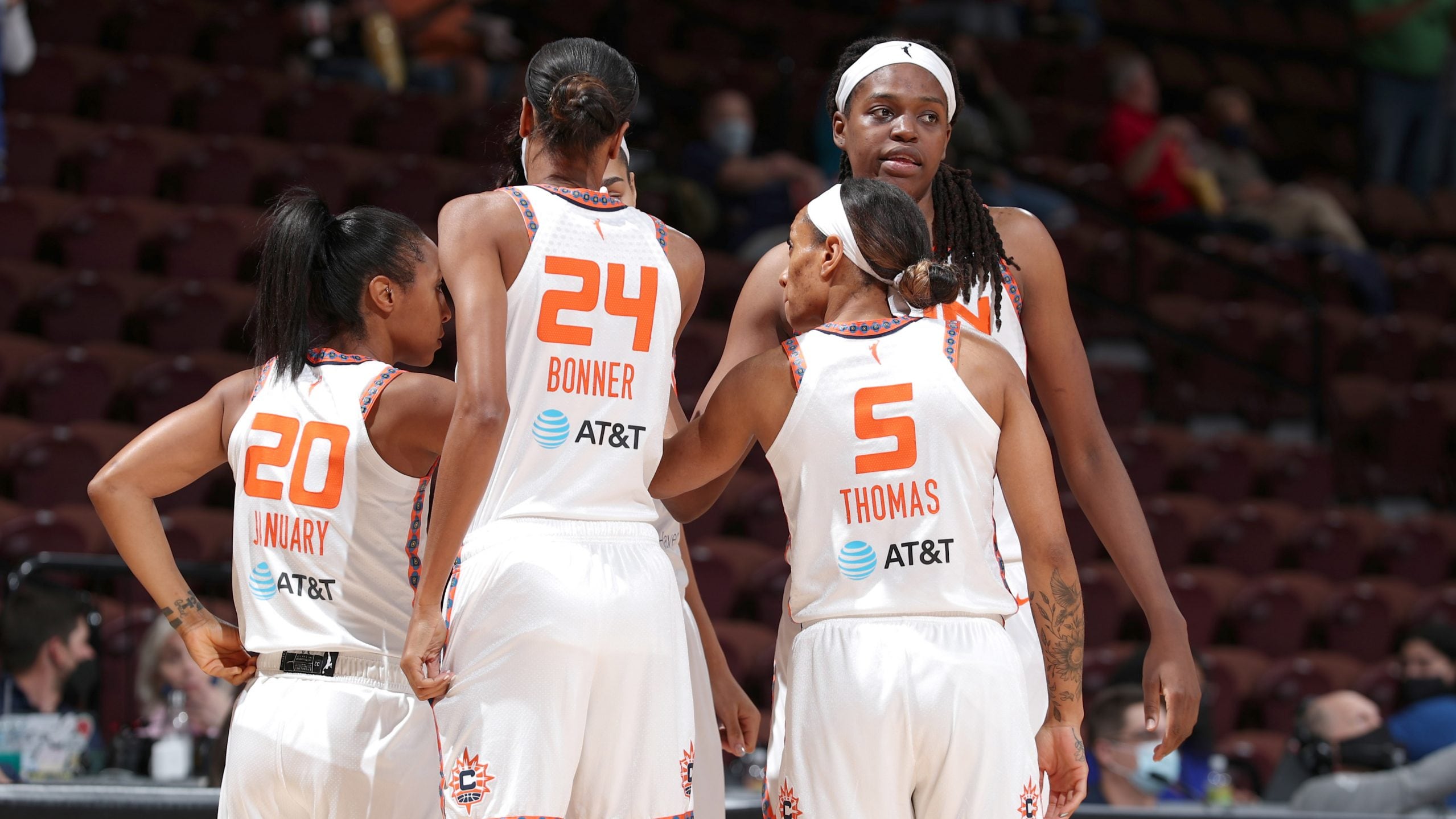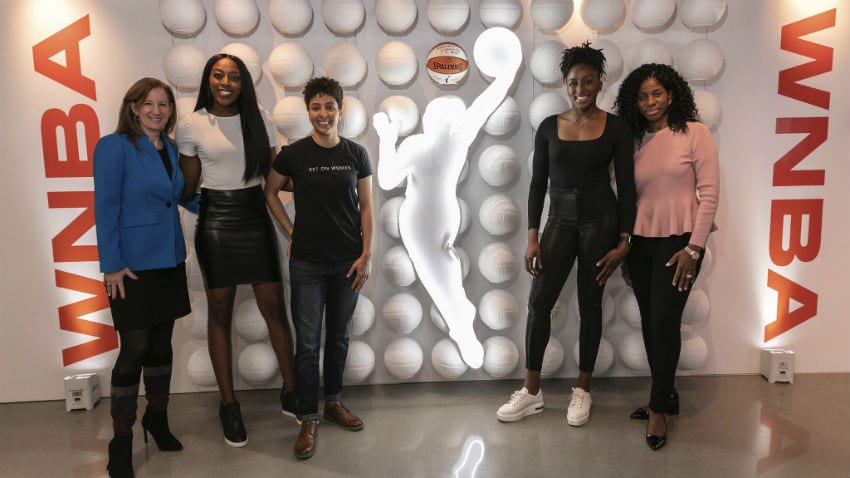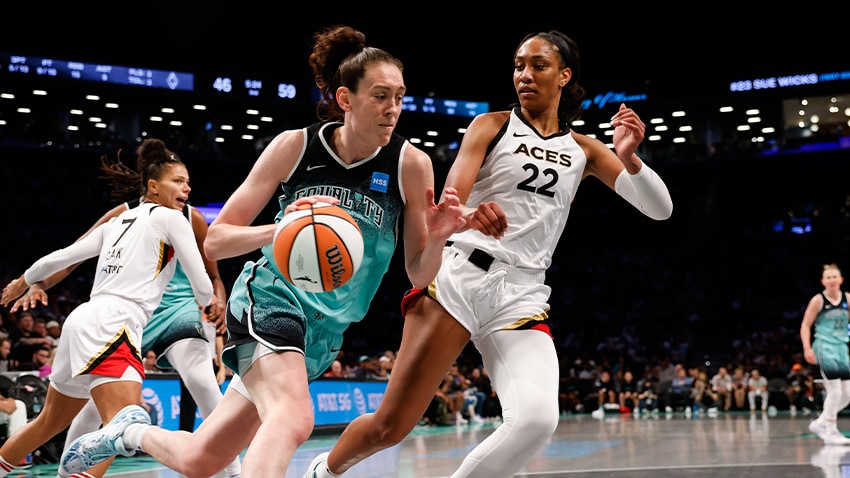Connecting with Commish: A Conversation with Commissioner Cathy Engelbert on the Commissioner’s Cup, Her Background in Basketball, and More
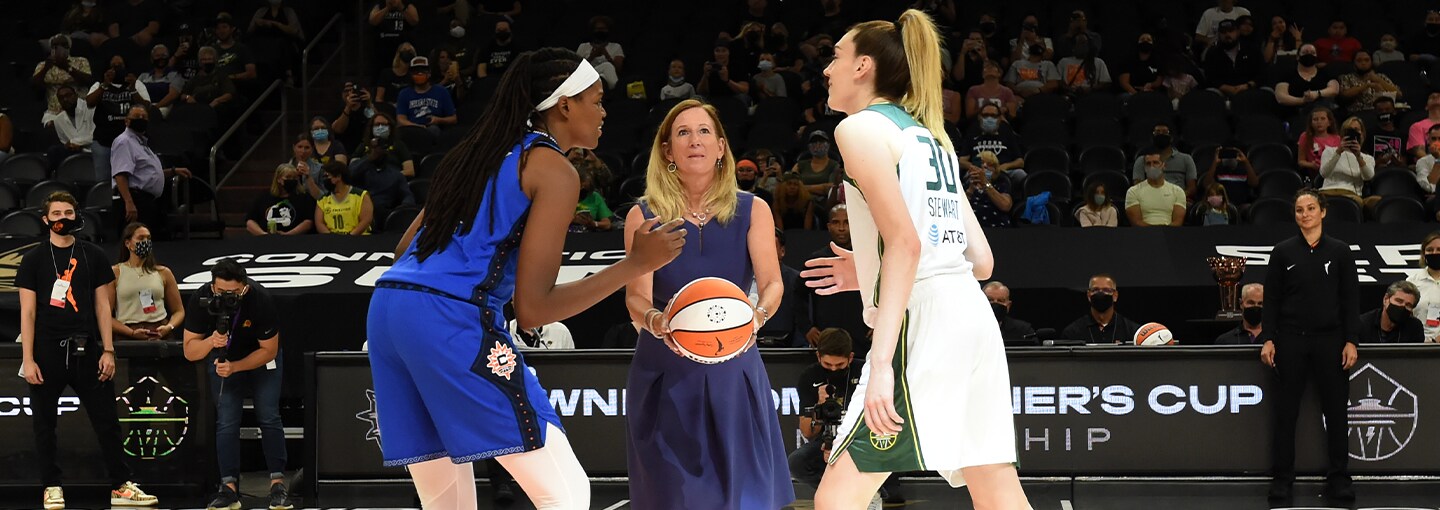
The Chicago Sky and Las Vegas Aces are set to face off tonight (7/26) at 8:30 pm ET for the 2022 WNBA Commissioner’s Cup Championship Game presented by Coinbase, with the game available to watch live on Amazon Prime Video. For a breakdown of the match-up, the lead-up to it, how to watch the game, and more, read up on the preview released earlier this week.
Ahead of the game itself, I sat down for a one-on-one with Commissioner Cathy Engelbert to discuss the Commissioner’s Cup at present, plans for the competition moving forward, lessons learned during the inaugural year and some insight on her day-to-day work as Commissioner.
Mark Schindler: Looking back at this past year, how did you feel the initial implementation of the Cup was received? What made you feel it was a success?
Cathy Engelbert: We saw it as an opportunity to grow rivalries around the league, enhance the player experience, and of course, increase their compensation with the half-million dollar prize pool. The cup designation to those first 10 intra-conference games during the regular season also gave more meaning to the first half of the regular season. It gives fans another journey to follow to see if their teams can make it into a different championship game than the WNBA Finals because, obviously, only two teams are going to get there. We had two great teams last year in the Connecticut Sun and the Seattle Storm, with the Storm winning the first inaugural Commissioner’s Cup championship. Each player on the winning team took home $30k(!), with Breanna Stewart bringing home the Commissioner’s Cup Championship MVP. The players were excited about it, especially for the increased compensation.
Again, this year, I’m excited for two of the best teams in the league, with Las Vegas and Chicago competing for that half-million dollar prize pool. One thing that shows the success of the inaugural season is we have a presenting partner this year in Coinbase, which is the first step in growing this into a new revenue-generating asset and ascribing and validating the value of an in-season competition. Last year, we held the game at a neutral site in Phoenix; we didn’t know who was going to be in it when we picked the location, but we thought we needed to be prepared for it, especially as we were still in COVID times last year. And this year, it’s exciting to have it in an arena with the team with the best record because we had to go to multiple tiebreakers as they both had the same record in Commissioner’s Cup play, then we went to head-to-head, and they had the same record. So then we had to go with the best record in all of the first half of the season.
And also, a success is having it streamed on Amazon Prime Video. Last year was the first time Amazon Prime Video had done a streaming deal with a women’s sports league; we actually even predated the NFL deal that they did. So we’re looking forward to having them stream the game on the Prime Video platform.
MS: Along those lines, it’s only the second year, of course, but have you contemplated a mid-season tournament or finding a way to differentiate or market Cup games differently? During the year, there was some confusion amongst fans and players on what was or wasn’t. Where are you at right now with that process?
CE: Whenever you launch something new, it’s important to give it three to five years to build recognition to be viewed in the marketplace as a differentiated part of your season. Given the fairly short season compared to men’s sports leagues, it’s hard to have a mid-season competition outside of the regular season. That’s why we designated Cup games in the first half.
Rivalries create compelling content, and compelling content gets viewers and eyeballs on your game. So, I think that for the Commissioner Cup, in a few years, fans will definitely recognize it; players definitely already understand it now in year two. It’s also an opportunity for us to do some innovation during the Commissioner Cup Championship game because the game doesn’t count towards the regular season standings.
I think by not doing a mid-season tournament but repurposing 10 regular season games in the first half, it allows us to pay the players more, and there is only one additional game for two teams because we’re always trying to find ways to pay our players more, which is important to them and our fans. And then, it’s been a win-win. But again, it’s going to take a couple of years for it all to be understood. And we can even test out new formats or rule changes and wearables and optical tracking and things like that. We’re not going to do a lot of that this year because we just came off of a big All-Star Weekend, where we did some different things.
MS: Going back into that, you mentioned optical tracking and wearables; what has you intrigued by that moving forward?
CE: Wearables are something you have to negotiate with the Players Association and install technology into the arenas. Since the game’s location couldn’t be confirmed (in Chicago) until a few weeks ago, we won’t be doing that this year. We did get it on a limited basis last year since we held the game in a neutral site determined well before we knew who was playing. The optical tracking to me is a really exciting thing to me. That’s when you see what’s happening, similar to a bird’s eye view in tennis. They’re using the eye versus humans to make the in-and-out calls. And so optical tracking has an enormous interest in terms of integrating into a broadcast. And we were the first league ever to integrate it into a broadcast in the Commissioner’s Cup Championship game last year. Again, it was just a one-off test that we’d like to continue to do, and we’ll work between now and next year on seeing where else we can integrate wearables. I think All-Star and the Commissioner’s Cup Championship are the two places to test to see if there’s something that could be built in more fully during the regular season and into playoffs.
MS: How do you feel the game has been received by players so far in terms of what the game and format are right now and how they feel about its future?
CE: I think they’re definitely receiving the game well, after we handed that trophy and the money last year with Sue Bird accepting, talking about how important it was for everyone on the team, including rookies and young players, to be recipients of that prize pool… just the pride they had in winning it.
Again, it’s going to take three to five years for everyone to understand how we’re trying to build these rivalries in the first half of the season and then give more opportunities to provide players compensation, and this was one of the ways that did that. And we promised that we would do that when we talked to the players when I first came into the league. We’re chipping away at that. At All-Star, I announced we’re upping the prize pool for playoff bonuses to half a million dollars so it will match the Commissioner’s Cup prize pool. That’s a big increase there. Again, we’re just chipping away at making sure the players know that we’re looking out for them. And we’re always looking for these opportunities. The Commissioner’s Cup was a great way to do it. But we’ll continue to chip away at that.
MS: To deviate from the Commissioner’s Cup a bit, I feel like people have a general idea of what a Commissioner does in sports but maybe don’t have great insight into what your daily work life might be like. I’d assume there’s a ton of variance, but how would you describe your day-to-day?
CE: In season, I’m on a 12-city tour. Right now, I’m in LA, and then I’ll be headed to a New York game on Saturday night and then the Commissioner’s Cup Championship in Chicago on Tuesday. So, an in-season kind of day in life is a day on the road. Because again, I love the game, and there’s nothing I like better than the game! It’s funny because people like to talk to me during the games, but I like to watch the game, you know! In the off-season and even during the season, the one thing to realize is that sports is big business, and big business is all about relationships. So in the off-season, it’s all about relationship meetings, meetings with partners and sponsors – whether it’s selling a partnership sponsorship for the league or meeting with owners. Now we have new investors, meeting with the NBA, and participating on the NBA senior leadership team. It’s a pretty interesting job; I’ll say it’s very multi-dimensional. It’s very, very busy. And just a little anecdote, and I said this in front of an executive group at a group called the Business Council recently. I just met with the CEO of US Bank, and he remembered what I said: One aspect I didn’t realize at my old job, all of my meetings were during the day. And then sometimes I had work dinners and things like that, but I had the nights off. Now, in the WNBA, most of the games, except for weekends, are at night! So you actually start your day at the same time, but now you’re going until, like, last night, I got back to the hotel room close to midnight Pacific, which was 3:00 am ET, and I started in New York yesterday morning. It’s a lot of hours, but I love it because I am passionate about the game and the job. I’ll never forget, when I first joined the league, someone told me, ‘you know, you have to stay up until every game is over West Coast time’ And I just chuckled and didn’t realize that, oh, yeah, the day to day as a sports Commissioner has a much different schedule than a CEO.
MS: What would you consider the hardest or most difficult part of your job?
CE: It’s funny you ask because one of the referees asked me last night if it was harder leading Deloitte or leading the WNBA? And I said, you know, they both have differences and similarities. Deloitte, it was 100,000 people; it was very complex. It was very technical. Here, it’s 144 players. It’s not as technically complex, but it’s very public-facing, and we’re in this social media world. I just did my third full season, and it’s been interesting with a lot of things that have happened in the world. So I think the hardest part is the publicity and that everybody thinks the offseason is a break. Here’s a little pearl of wisdom; Everyone thinks the offseason is the easy part of being a Commissioner. Ironically, it’s actually the most challenging part! Because once the season starts, it’s kind of like you have this warm feeling come over you because there’s competition. There’s a lot to write about for the media. We also face challenges during the season, but the hardest part is the offseason. How do we ensure that we’re sticking with our strategy of being very player first, ensuring our stakeholders have success, and driving fan engagement? During the season, you have the built-in joy of the game, and in the offseason, you have to determine how to execute the strategy.
MS: I know you’ve been in business most of your life prior to starting up with the W, but what was your relationship with the game like in life before the past few years? Is it something you’d always been around?
CE: I do have some basketball DNA because my father was drafted into the NBA in 1957 by the Detroit Pistons. A lot of people don’t know that! And actually, when I was interviewed for the job, I told Adam Silver that, and a couple of days later, he said, oh, yeah, we found that out because the Detroit Pistons have that in their database! By the way, his salary back in 1957 for the Pistons would have been $900 for the year. So he went on to a career at RCA and IT instead because basketball was not as lucrative as joining a corporation back then. So anyway, that DNA, and then I went on to play college basketball for Muffet McGraw. This was at Lehigh University, where she so-called ‘cut her teeth in coaching’ and then went on to Notre Dame to turn that program around in two national championships and the Naismith Hall of Fame. So that’s kind of what gave me the passion to even look at this job. The WNBA did not exist when I got out of college in 1986. I do not think I would have been good enough to play, but I would have tried out, I assure you! Because I still wanted to play and did play in a little league in Philadelphia when I started my career on Sundays. I was the only female on the team. I just love the game.
MS: Ok, so I have to hear what your game was like. You said were you a guard, but what’s your play style?
CE: Back in high school, I was a 2-guard. I was the scorer while my sister was the point. My sister and I used to make up plays called “S”, which stood for Sister plays, and the coach never knew about it, and she’d come down and call S, and the coach would be like, there’s no S play! But that was the play that we practiced in the backyard. Then in college, the point guard at Lehigh got hurt my freshman year, and I stepped in and then started every game from that point on and was our East Coast Conference MVP my senior year for the tournament. I reveled in getting an assist rather than scoring, so I was an assist and steals machine. We had some great players on that senior team.
MS: The last thing I really want to dive into is how has that relationship-building aspect been for you? You mentioned that being such an important aspect of your job, and I’ve always wondered how that works. How do you work on relationship building with players and balance that with your job as Commissioner?
CE: Every team is a little different in how they want me to engage with players. And I think there’s been some advantages and some huge disadvantages of these COVID times in relationship building with the players. In 2020 we were in the bubble, so I actually did get to interact with players a fair amount and build a bit of a relationship with them. I do wish that If COVID hadn’t been here, I think I would have had a lot more opportunities to meet players for dinner or lunch or breakfast after a game. But I always like to personally call all of the All-Stars and the potential draftees for the first round of the draft; I’ll call all the season award winners. And that’s, you know, important to make those personal touch points. And keeping the PA and Executive Committee relationship going and talking through issues that players are encountering throughout the season is one important part of the relationship too. The longer I have in this role, the more relationships I’ll be able to build with players, and that is my goal. I’m so impressed with the players, whether it’s just their play on the court or them being moms and entrepreneurs, social justice champions and advocates for so many underserved communities, and so community-minded and socially conscious that I just really admire them from that perspective.
Major thanks to the Commissioner for taking the time! It was great to get to know more about her, as well as get some insight into the direction of the Commissioner’s Cup. Before the conversation, I didn’t have the most concrete picture of everything that goes into her role and what her daily work life was like, so getting the opportunity to develop a better understanding of who Cathy is as a person and how she goes about her work was really enlightening.
I certainly wouldn’t have guessed (or known) Cathy Engelbert was a pass-first point guard!
With the Cup just ahead of us tonight, I look forward to using this as an inflection point in its growth. Kelsey Plum mentioned the focus of the Aces on going out and winning the Cup Championship when asked about the remainder of the season by Pepper Persley after they defeated the Sparks on Saturday night. Winning the game and the prize pool that comes with it is at the forefront. As the regular season expands next year and league prioritization ramps up, I’m really intrigued to continue to witness and track the growth of the Commissioner’s Cup, its impact on the league at large, and how it continues to evolve.
WNBA reporter Mark Schindler writes a column on WNBA.com throughout the season and can be reached on Twitter at @MG_Schindler. The views on this page do not necessarily reflect the views of the WNBA or its clubs

